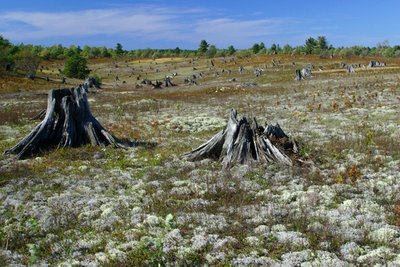I've seen fire damage before. We drove through an area burned during the horrible California wildfires several years ago. Periodically we have grass fires in our area of Texas. In Central Texas when we have grass fires, the ground is left black. We have visited Yellowstone after the massive fires there. We learned about how fire makes mosaics - where some areas burn more than others, and some areas are left untouched. Even so, I was startled by the fire damaged area in the Panhandle.
We first saw fire signs along I-40 where there was an area where the fire burned along the right of way and in the median, but somehow they were able to keep it from burning any of the pasture, the burned area ended right at the fence line. We saw a service station set back from the road that was totally burned - flattened.
We found a road to head north where we were hoping to drive through miles and miles to get a sense of what the fires had done. We were in the "breaks" along one of the forks of the Red River. The fire had burned through some of the canyon areas where it would be difficult to fight. In some places, the ground was totally scoured - not black from fire, no blackened grass, just dirt and the remnants of yucca. We could see where they had replaced telephone poles because the bases had completely burned through. There were fences . . . . .some had the wooden posts partially burned, but in other areas nothing was left of the posts - nothing. All that was left of the fence were the strands of wire on the ground. But the mosaic effect held true. You would have a quarter mile or so of wires on the ground - then a few fence posts that were only partially burned. You would see fences that were mainly the metal t-bars that had wooden posts evey 10 posts or so. Some of these wooden were burned all but the top foot that was still hanging from the wires.
There was an area of sand dunes. Normally these have vegetation growing such that you might not realize this was sand. Now it is barren. For the land to be this devoid of anything living makes me think the fires were very hot. It also has me a little concerned that the topsoil may have been damaged from the heat - which could make it more difficult for the grass and prairie to recover.
We've seen that in Michigan. On the upper penninsula there in an area called the Kingston Plains, there are areas that used to be forested that are now barren because the topsoil was "sterilized" by wildfires over one hundred years ago. The only thing that grows there are spongy cladina lichens. The stumps from the massive logging are all that remain of the forest. I hope that the soils here in the Panhandle do not have that kind of damage.

In retrospect, I also realize that while I saw remnants of yucca, I did not see remnants of prickly pear cactus or cholla cactus. I know from past research that fire is one of the recommended ways to get rid of unwanted cactus. So . . . . . .if the land recovers there may be some blessings . . . . . later.
However, we also saw human tragedy. In some places the fires came right up to people's yards on their farms and ranches. The firemen obviously did a great job saving the structures. But some were not so lucky. We saw houses with nothing left but the foundation. We saw silos where the roofs now sat on the ground - all that was left - the metal roof. We saw what must have been barns totally destroyed.
I know from the news reports that both cattle and horses died in the fires. We saw some cattle grazing on areas that were spared. They were the lucky ones. On much of the burned areas, there will be no pasture this year. For those that had surviving herds, they will have to be moved or sold. And we did see where fresh round bales had been brought in.
Farming and ranching in west Texas is difficult. Rainfall is scarce, the aquifer that provides water for living and irrigation will some day be depleted and there are storms every year that bring damaging hail to someone's land. I fear that some of these ranchers may not have enough reserves for their agribusiness to survive this kind of devastation.
However, the generous nature that God gave people is also kicking in. People are helping each other. When I went in to exercise at the Curves in Amarillo, there was a sign talking about the collection of money to help those who had been affected by the fires. Ranchers and hay growers from other areas are trying to get feed in for the herds.
Henry and I hope to go back to see how quickly this area recovers. Fire is a natural part of God's care for the earth. Just as we learned a lot about the role of fire in nature with the Yellowstone fires, we will learn the benefits of prairie fires.
No comments:
Post a Comment